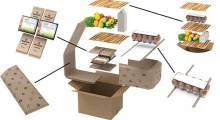I’ve been interested in the systems-based approach to design since I was introduced to the idea by Mark White, a professor emeritus at Virginia Tech and one of the most knowledgeable people I know when it comes to pallets and industrial packaging.
White’s premise is that materials handling systems, unit load packaging and transportation processes are designed in a vacuum. One group rarely talks to the other. That leads to costly mistakes.
Some pallet and packaging suppliers have picked up on White’s concept. Recently, Ongweoweh, a provider of pallets and pallet management services, announced that they were launching a new unit load practice. I’m also noticing that solution providers outside the industrial packaging industry are also getting the message. Just last week, I listened to a presentation by Rite Hite about the importance of integrating loading dock equipment into broader materials handling and transportation processes.
Today, I had a similar conversation with Jeff Dehnert, president of Dehnco Equipment & Supplies, a supplier of industrial workbenches. Dehnco has been a proponent of something it calls W.I.S.E. The acronym stands for workstation integration system evaluation. In a nutshell, Dehnco’s message is similar to the pallet guys and the dock equipment providers: you may not think of a workbench as anything more than a piece of furniture, but if it’s not tied into your overall system, you create a bottleneck in your operations.
Changes in the size of trailers and rail cars has brought the importance of dock design to the fore. According to Dehnert, the increase in ecommerce order fulfillment is raising the profile of the industrial workbench. “We work with some of the largest retailers in the country,” Dehnert says. “The recurring problem they all have in common is that they have four distinct types of ecommerce orders to process and address.”
Those are single line orders, multiple line orders, orders that involve some type of value added service, especially gift wrapping and non-conveyables, like big comforters and over-sized pillows.
“The pain point,” Dehnert says, “is how to organize the packaging, materials handling and IT requirements for those distinct order types, especially during the peak period between Thanksgiving and Christmas. And the answer is that it’s not possible.”
Dehnert says that best practices are emerging. Retailers with sophisticated WMS systems that can distinguish between those different types of orders are developing different workbench setups for each type. “Rather than gift wrap at every workbench, they’ll set up an area just for gift wrapping and then send the wrapped order to a station handling just single line orders or multiple line orders,” Dehnert says.
But the biggest change is in the design of these processes, which sounds an awful lot like a systems-based approach to workbench design. “In the past, the conveyor guy, the workstation guy and the packaging guy all came in and did their work independent of one another,” he says. “Now, because retailers realize packaging can be a bottleneck, especially during peak, they are getting everyone together during the preplanning stage. That allows us to talk about how our piece of the puzzle is going to affect the other players rather than try to integrate it all together later.”
Dehnert’s takeaway: “Ecommerce order fulfillment is forcing all of the vendors in the work area to get together and come up with a really efficient solution,” he says. “It’s the biggest change I’ve seen in years and it’s a big win for the customers who take that approach because we all have a better understanding of what they’re trying to accomplish.”
Sounds pretty wise to me.







